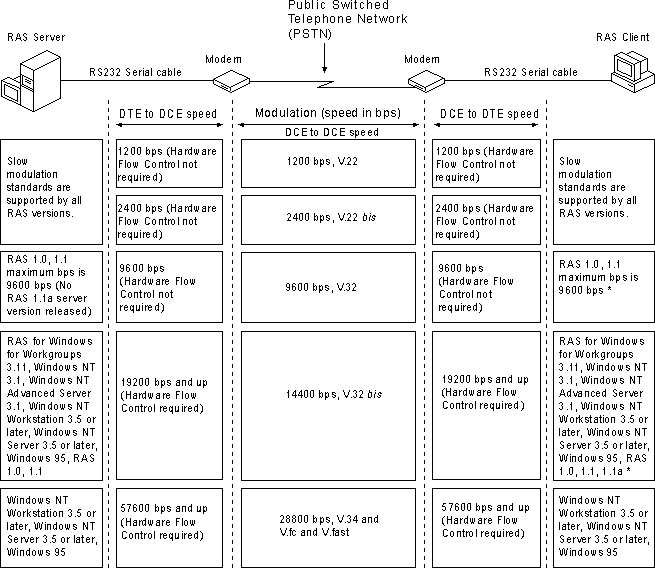
The modem modulation standards affect the telephone line speed compatibility between two modems, as shown in the following Table E.1. For two modems to communicate, their modulation standards must be compatible.
The modulation standard only defines the speed or permitted speed range between the modems. The speed between the computer and the modem can be different and depends on the serial hardware, the microprocessor speed in the computer, and whether or not hardware flow control or XON/XOFF software flow control is enabled.
Table E.1 shows the most popular modulation schemes in the left column and their corresponding speed range in bits per second (bps) in the right column.
Table E.1 Modulation Schemes and Modem Speeds
Popular modulation schemes | Modem-to-modem speed | |
V.22 (ITU-T (formerly CCITT) Standard) | 1200 bps | |
V.22 bis (ITU-T (formerly CCITT) Standard) | 2400 bps | |
V.32 (ITU-T (formerly CCITT) Standard) | 4800 to 9600 bps | |
V.32 bis (ITU-T (formerly CCITT) Standard) | 4800 to 14400 bps | |
V.fc and V.fast (Proprietary Modulation Schemes) | 2400 to 28800 bps | |
V.34 (ITU-T (formerly CCITT) Standard) | 2400 to 28800 bps | |
Figure E.2 shows that modulation standards take effect only on the modem-to-modem (DCE-to-DCE) link. Speeds between DTE and DCE are independent of modem modulation standards and often differ from the DCE-to-DCE speed. When speeds are different, hardware flow control or software flow control support is required so that data is not lost when transmission speed between the modems is less than transmission speed between the DTE and DCE, or when transmission between the modems is temporarily delayed due to retransmission of data that was corrupted during transmission. RAS versions 1.0 and 1.1 do not support hardware or software flow control. RAS versions 1.1a and later support hardware flow control.
Figure E.2 also displays the different modulation standards below the DCE-to-DCE link to which they apply. The column to the right of the center column displays the RAS clients' DCE-to-DTE speeds that occur in relation to the DCE-to-DCE speeds on the same row in the center column. Depending on your modem's capabilities, these speeds should be set in the corresponding RAS client versions that are displayed in the far right column. The highest supported DTE-to-DCE speeds that should be set on the RAS server (depending on its modem[s] capabilities) are displayed in the column to the left of the center column. The rightmost column lists the RAS client versions and the leftmost column lists the RAS server versions whose highest supported modulation rate corresponds to the modulation standard in the center column.
For example, in the "9600 bps, V.32" entry in the center column, the columns to the left and right show that the DTE-to-DCE speeds are also 9600 bps, and that this was the highest supported modulation mode of RAS versions 1.0 and 1.1.

Figure E.2 Modulation Standards and RAS
*RAS 1.0 and 1.1 were tested only with US Robotics V.32 bis modems at 14400 bps line speed. The modems were configured for V.42, V.42 bis, and V.32 bis. The OS/2 1.3 LAN Manager RAS 1.0 or 1.1 server had an intelligent DigiBoard installed.